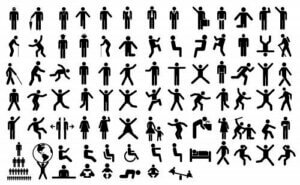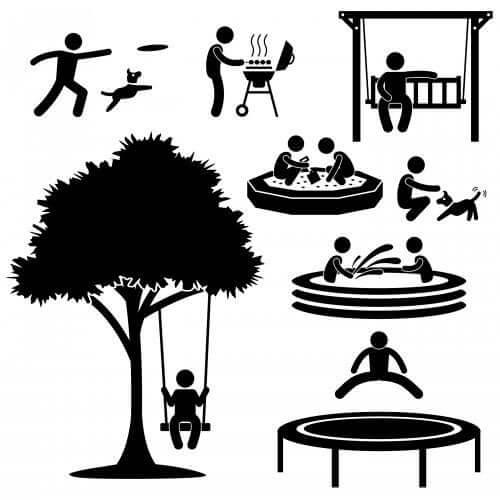PECS: Picture Exchange Communication System

PECS stands for Picture Exchange Communication System. This system was created by psychologist Andrew Bondi and speech therapist Lori Frost in 1985. Its main purpose is to work as a basis to start and improve communication in people who have problems in that area.
At first, they created it for children and adults with autism spectrum disorder (ASD). However, currently, any person with communication difficulties can use it.
PECS: picture exchange communication system
According to Javier Tamarit, psychologist, an augmentative and alternative communication system is:
“A tool for educational and speech therapy for people with communication disorders or language impairments. Its main goal is to teach, through specific instruction procedures, a set of nonverbal codes. In addition, these codes allow representation functions and communication acts (functional, spontaneous and general). These acts can stand on their own, or as a set of verbal or nonverbal codes.”
– Javier Tamarit –

So, PECS is an augmentative and alternative communication system, which is based on the exchange of images or pictograms.
The 6 phases of PECS
To implement PECS on children with language impairments or communication difficulties, you have to follow different phases:
1. Phase 1: how to communicate. The child learns to exchange pictures for items (objects or activities) that another person (teacher, family member, therapist, etc.) receives.
2. Phase 2: distance and persistence. The child learns to generalize this new skill by using it in different places, with different people and across distances.
3. Phase 3: picture discrimination. The child learns to select, from two or more pictures, the one they need to answer for the request.
4. Phase 4: sentence structure. The child learns to construct phrases or sentences by choosing the pictogram “I want”, and adding the image of the desired item. In time, the child develops the ability to construct complex sentences, using verbs, adjectives and prepositions.
5. Phase 5: responsive requesting. The child uses different pictograms and learns how to answer questions, such as “what do you want?“, “what do you need?“, etc.
6. Phase 6: commenting. Through images, the child learns to construct phrases and sentences that start with a verb, in order to answer complex questions, such as “what do you see?”, “what do you hear?”, “what do you feel?”, etc.

Through this process, children learn progressively until they’re able to communicate naturally, through pictograms exchange.
Advantages of picture exchange communication system (PECS)
As we all know, communication is an essential part of our lives. Therefore, it’s important that children develop this skill, even though, some may have difficulties in language production. In these cases, it’s necessary to promote functional, spontaneous and general language, by using methods like PECS.
In addition, using this method is a good choice because it’s simple and easy to understand. As well as favoring the communication act, PECS allows:
- Improving vocabulary and capacity of expression.
- Improving social and communication skills (joint attention, request, initiation, cooperative games).
- Adapting to the speaker’s needs.
- Reducing behavioral problems and frustrations.
- Increasing the possibility of articulating words.
PECS stands for Picture Exchange Communication System. This system was created by psychologist Andrew Bondi and speech therapist Lori Frost in 1985. Its main purpose is to work as a basis to start and improve communication in people who have problems in that area.
At first, they created it for children and adults with autism spectrum disorder (ASD). However, currently, any person with communication difficulties can use it.
PECS: picture exchange communication system
According to Javier Tamarit, psychologist, an augmentative and alternative communication system is:
“A tool for educational and speech therapy for people with communication disorders or language impairments. Its main goal is to teach, through specific instruction procedures, a set of nonverbal codes. In addition, these codes allow representation functions and communication acts (functional, spontaneous and general). These acts can stand on their own, or as a set of verbal or nonverbal codes.”
– Javier Tamarit –

So, PECS is an augmentative and alternative communication system, which is based on the exchange of images or pictograms.
The 6 phases of PECS
To implement PECS on children with language impairments or communication difficulties, you have to follow different phases:
1. Phase 1: how to communicate. The child learns to exchange pictures for items (objects or activities) that another person (teacher, family member, therapist, etc.) receives.
2. Phase 2: distance and persistence. The child learns to generalize this new skill by using it in different places, with different people and across distances.
3. Phase 3: picture discrimination. The child learns to select, from two or more pictures, the one they need to answer for the request.
4. Phase 4: sentence structure. The child learns to construct phrases or sentences by choosing the pictogram “I want”, and adding the image of the desired item. In time, the child develops the ability to construct complex sentences, using verbs, adjectives and prepositions.
5. Phase 5: responsive requesting. The child uses different pictograms and learns how to answer questions, such as “what do you want?“, “what do you need?“, etc.
6. Phase 6: commenting. Through images, the child learns to construct phrases and sentences that start with a verb, in order to answer complex questions, such as “what do you see?”, “what do you hear?”, “what do you feel?”, etc.

Through this process, children learn progressively until they’re able to communicate naturally, through pictograms exchange.
Advantages of picture exchange communication system (PECS)
As we all know, communication is an essential part of our lives. Therefore, it’s important that children develop this skill, even though, some may have difficulties in language production. In these cases, it’s necessary to promote functional, spontaneous and general language, by using methods like PECS.
In addition, using this method is a good choice because it’s simple and easy to understand. As well as favoring the communication act, PECS allows:
- Improving vocabulary and capacity of expression.
- Improving social and communication skills (joint attention, request, initiation, cooperative games).
- Adapting to the speaker’s needs.
- Reducing behavioral problems and frustrations.
- Increasing the possibility of articulating words.
All cited sources were thoroughly reviewed by our team to ensure their quality, reliability, currency, and validity. The bibliography of this article was considered reliable and of academic or scientific accuracy.
- Palacios-Menor, M. (2015). Eficacia del sistema PECS para el desarrollo comunicativo y lingüístico en niños con Trastorno del Espectro Autista (Trabajo de Fin de Grado). Universidad de Castilla-La Mancha, España.
- Pyramid Educational Consultants. (s.f.). El sistema de comunicación por el intercambio de imágenes (PECS). Barcelona, España. Recuperado de: https://www.pecs-spain.com/el-sistema-de-comunicacion-por-el-intercambio-de-imagenes-pecs/
- Tamarit, J. (1989). Uso y abuso de los sistemas alternativos de comunicación. Comunicación, lenguaje y educación, 1(1), 81-94.
This text is provided for informational purposes only and does not replace consultation with a professional. If in doubt, consult your specialist.








